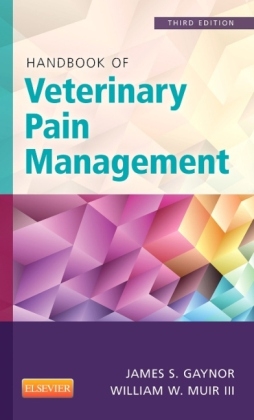
Handbook of Veterinary Pain Management
Mosby (Verlag)
978-0-323-08935-7 (ISBN)
The latest information on complementary and alternative strategies for pain management offers the guidance to help you incorporate non-pharmacologic treatments into their pain management programs.
Numerous boxes and tables summarize pharmacologic protocols and clinical applications, with dosages, indications, contraindications, and side effects to provide you with the comprehensive drug information needed to find the most effective and appropriate treatment.
User-friendly format helps you quickly and easily find essential information.
Case studies illustrating realistic clinical scenarios help you learn how to assess and manage pain in the clinical setting.
NEW! Eight new chapters include the latest information on:
the human-animal bond
local and regional techniques
preventive and multimodal analgesia
energy modalities
acupuncture
physical examination with emphasis on isolating and locating pain
therapeutic goals
pain in laboratory animals
NEW! Completely updated drug information, with new agents, doseforms, and routes provides the most current pain management therapies for use in the clinical setting.
NEW! Expanded sections on the cat and exotics address the growing popularity of these pets by providing additional species-specific information.
William W. Muir, III, DVM, MSc, PhD, DACVA, DACVECC, is Chief Medical Officer at The Animal Medical Center in New York and a recently retired professor in the Department of Veterinary Clinical Sciences at The Ohio State University College of Veterinary Medicine. Dr. Muir is board certified in both anesthesiology and emergency and critical care. He was a distinguished professor at Ohio State for over 20 years and trained many anesthesiologists in the US and abroad. He also has written hundreds of journal articles, is the recipient of many professional awards, and is the co-author of Elsevier's Handbook of Veterinary Pain Management (with Gaynor) and Equine Anesthesia: Monitoring and Emergency Therapy (with Hubbell).
1. The Human-Animal Bond and Pain
2. Nociception and Pain Mechanisms
3. Pain: Physiologic Consequences and Stress
4. Pain Nomenclature
5. Pain Behaviors and Pain Assessment Scales
6. Quality of Life Assessment
7. Drug Classes and Drugs Used for Pain Therapy: An Overview
8. NSAIDs
9. Opioids
10. Alpha-2s
11. Local Anesthetics
12. Local and Regional Anesthetic Techniques
13. Corticosteroids
14. Other "Drugs and Injectable Modalities
15. Drug Delivery Methods
16. Preventative and "Multimodal Analgesia; "Masking and Pitfalls: Theory and Consequences
17. Energy Modalities: Therapeutic Laser and Pulsed Electromagnetic Field Therapy
18. Acupuncture
19. Physical Rehabilitation and Exercise
20. Physical Examination with Emphasis on Isolating and Detecting Pain
21. Therapeutic Goals
22. Acute Pain Cases
23. Chronic Pain Cases
24. Cat Specific Considerations
25. Rabbit and Small Mammal Specific Considerations
26. Bird Specific Considerations
27. Reptile Specific Considerations
28. Regulations in Pain and Distress in Laboratory Animals
| Zusatzinfo | Approx. 140 illustrations; Illustrations |
|---|---|
| Verlagsort | St Louis |
| Sprache | englisch |
| Gewicht | 660 g |
| Themenwelt | Veterinärmedizin ► Klinische Fächer |
| ISBN-10 | 0-323-08935-6 / 0323089356 |
| ISBN-13 | 978-0-323-08935-7 / 9780323089357 |
| Zustand | Neuware |
| Haben Sie eine Frage zum Produkt? |
aus dem Bereich


